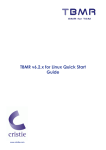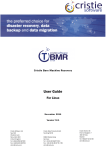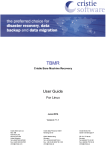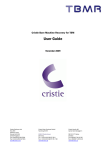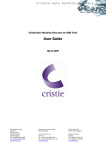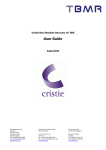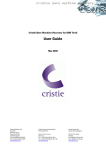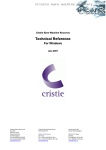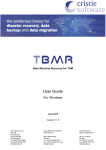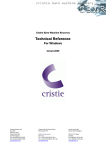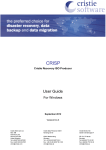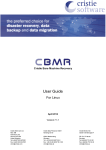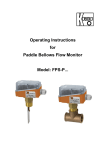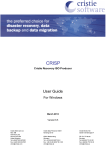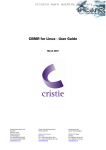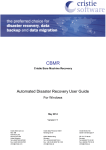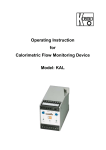Download TBMR für Linux 6.12 Quickstart Guidex
Transcript
T TBMR for Linux 6.1.2 Quick Start Guide March 2009 Cristie Data Products Ltd. New Mill Chestnut Lane Stroud GL5 3EH United Kingdom Cristie Nordic AB Gamla Värmdövägen SE--131 37 Nacka Sweden Cristie Data Products GmbH Nordring 53-55 63843 Niedernberg Germany Tel:+44(0)1453 847000 Fax:+44(0)1453 847001 Tel:+46 (0) 8 718 43 30 Fax:+46 (0) 8 718 53 40 [email protected] Tel: +49 (0) 6028 97 95-0 95 Fax: +49 (0) 6028 97 95-7 95 99 [email protected] [email protected] www.cristie.com Der Inhalt dieser Dokumentation ist Eigentum der Cristie Data Products GmbH und unterliegt dem Urheberrecht. Änderungen und Reproduktionen, auch von Teilen des Dokumentes, bedürfen der schriftlichen Genehmigung. © 2006 Cristie Data Products GmbH. Alle Rechte vorbehalten. Contents DESCRIPTION ................................................................................................ ................................ .......................................... 3 SYSTEM REQUIREMENTS ................................................................ ........................................................................................... 3 INSTALLATION ................................................................................................ ................................ ......................................... 3 SETTING UP A BACKUP LOCATION ................................................................ .............................................. 4 SETUP TSM BA CLIENT .............................................................................................. ................................ .............................. 4 SAVING CONFIGURATION................................................................ .......................................................................................... 4 TBMRCFG ................................................................................................ ................................ ................................................ 4 BACKING UP ................................................................................................ ................................ ............................................ 6 TSM BA CLIENT BACKUP............................................................................................. ................................ ............................. 6 RECOVERY ................................................................................................ ................................ ............................................... 6 LOAD HARDWARE DRIVERS ................................................................ .......................................................................................... 7 ACCESS CONFIGURATION............................................................................................. ................................ ............................. 8 FROM REMOTE SHARE ................................................................ .......................................................................................... 9 SETUP NETWORK ................................................................ ....................................................................................... 9 SETUP REMOTE SHARE ................................................................ ...............................................10 SELECT CONFIGURATION ................................................................ .............................................11 FROM LOCAL DEVICE................................................................ ...........................................................................................11 SETUP LOCAL DEVICE ................................................................ .................................................12 READ CONFIGURATION FROM LOCAL DEVICE ..................................................... ................................ 12 FROM TSM BA CLIENT BACKUP ................................................................ ..............................................13 SETUP NETWORK ................................................................ ......................................................................................13 SETUP TSM SERVER ................................................................ ..................................................................................14 READ CONFIGURATION FROM TSM ................................................................ .................................14 TEST BACKUP LOCATION ............................................................................................ ................................ ............................15 RECOVERY MACHINE ................................................................................................ ................................ .................................15 TBMR – Quickstart Guide 2 Description Cristie Bare Machine Recovery for IBM Tivoli (TBMR) for Linux can recover a Linux machine in the event of a disaster. It is possible to recover to the same or dissimilar hardware. Command line and GUI interfaces are available. able. Backups can be taken periodically along with configuration information which includes details of hard disks, network interfaces, etc. This quick start guide shows the user how to configure backup locations, save configuration, backup and recover a Linux Li machine using TBMR. More detailed information is available from man pages for the TBMR components. System Requirements TBMR for Linux can be installed on a x86, x86_64 or PPC Linux machine with glibc >= 2.2. If using TSM, the system should have TSM API API client version >= 5.1 already installed. For TBMR backups, TSM BA client should be installed. Recovery requires at least 128MB RAM. Installation Installation files may be downloaded from Cristie website at http://www.cristie.com or can be found in the linux/install directory on the TBMR CDROM. There are 2 available versions to support newer and older Linux distributions. The main installation files are contained in the linux/install/main directory and the installation installation files for older distributions are contained in linux/install/compat. There are readme.txt files in both directories explaining which common distributions are supported by which files. If the system supports Redhat Package Manager (RPM), this is the simplest way to install TBMR. To install from an RPM package: rpm -i tbmr-xxx.xxx.rpm To uninstall the RPM package, use rpm -e tbmr If RPM is not available, the gzipped tar file may be installed as follows: Copy the installation file to a temporary directory. tar xvzf tbmr-xxx.linux.xxx.tar.gz xxx.linux.xxx.tar.gz cd tbmr ./install This will install all the relevant files and licences. To uninstall the package, use the install script with -u option. TBMR is installed with a 30 day trial licence. To extend this licence, contact Cristie at [email protected]. TBMR – Quickstart Guide 3 Setting Up A Backup Location Setup TSM BA Client If the backup is to be written using TSM BA client, the BA client dsm.sys file should be configured. The default location for TSM API client setup file is: /opt/tivoli/tsm/client/ba/bin/dsm.sys This file should be edited to point to the TSM server to be used: SErvername server_a COMMmethod TCPPort TCPServeraddress TCPip 1500 10.2.1.20 The TSM BA client should be configured to backup all files which are required for OS recovery. By default, the /dev directory is not backed up. To make sure this is is backed up, the following line should be added to the dsm.sys file: virtualmountpoint /dev This will create a separate filespace for /dev which will be restored by the recovery environment. Saving Configuration Configuration information including details of disks, networks, etc. must be saved for each machine to be recovered. This may be saved to the backup location, to a unique floppy disk or memory key for each machine, or to a central configuration store located located on a network share. When saving configuration information to the backup location, this must be done before the backup is run. To save the configuration information for each machine, a command line program tbmrcfg may be used. tbmrcfg To use the command line configuration saving program, type tbmrcfg followed by the required options. The available options to tbmrcfg can be shown using: tbmrcfg -? tbmrcfg vx.xx (c) Cristie Software Ltd. 2004-2008 2004 Usage: tbmrcfg [options] Options: TBMR – Quickstart Guide 4 -a[dir] -b<name>, --bootloader=<name> bootloader=<name> -c<dir>, --copyto=<dir> copyto=<dir> -d<name>, --bootdevice=<name> bootdevice=<name> -f, --floppy floppy -l<file>, --logfile=<file> logfile=<file> -o<file>, --output=<file> output=<file> -v, --verbose verbose --disshw=<n> disshw=<n> --filedev_mount_options=<string> filedev_mount_options=<string> --filedev_mount_target=<string> filedev_mount_target=<string> --floppy_device=<string> floppy_device=<string> --floppy_mount=<string> floppy_mount=<string> --format_pattern=<pattern> format_pattern=<pattern> --partition_pattern=<pattern> partition_pattern=<pattern> --licence=<licence> -?, --help, --usage usage Add files to backup (default dir /TBMRCFG) Set boot loader to <name> (default is lilo) Copy files to <dir>/<hostname> Set boot device name to <name> Copy required files to floppy disk Set log file (default is tbmrcfg.log) Set output file (default is disrec.ini) Verbose mode Use dissimilar hardware support if n != 0 Set file device mount options Set file device mount target Set the floppy fl disk device node Set the floppy disk mount point Only format devices matching pattern Only partition devices matching pattern Use licence code <licence> Print this message and exit Some examples are shown here: To save configuration information from a machine that boots using grub installed on /dev/sda to the backup location, use: tbmrcfg -b grub -d /dev/sda To save configuration information from a machine that boots using grub installed on /dev/hda to an NFS mounted share /nfs/configs, /nfs/configs use: tbmrcfg -b grub -d /dev/hda -c - /nfs/configs To save configuration information from a machine that boots using grub installed on /dev/sda to a removable disk device /dev/sdc which can be temporarily mounted at /mnt/tmp, /mnt/tmp and backs up to a file location mounted using SMB in //server/share/directory, use: tbmrcfg -f --floppy_device=/dev/sdc floppy_device=/dev/sdc --floppy_mount=/mnt/tmp -b b grub -d /dev/sda -filedev_mount_target=//server/share -filedev_mount_options="username=me,password=secret,workgroup=mygroup" There is a full manual page for tbmrcfg available by typing man tbmrcfg. TBMR – Quickstart Guide 5 Backing Up TSM BA Client Backup The backup may be performed using the command line TSM BA Client dsmc or the GUI interface. Please consult the TSM user manual for instructions on how to do this. Recovery When a machine needs to be recovered it should be booted from the Cristie Recovery Console bootable CDROM. The machine's BIOS may need to be changed to boot from CDROM. Press L when the boot prompt appears and press Y to load any required drivers when prompted. prom Note that if the machine has access to SAN disks which should not be recovered and do not contain OS files, the drivers for these should not be loaded. The recovery console main menu should appear. The simplest way to recover a machine is to use the Automatic Recovery option. TBMR – Quickstart Guide 6 Load Hardware Drivers Some, but not all, device drivers are loaded automatically at boot time. If the disk controller and network drivers required for recovery were automatically automatically detected and loaded, the Load Hardware Drivers option may be ignored. If further drivers are required, or modules need to be listed or removed, this option should be selected. This menu may also be used to change the keyboard layout if the recovering system does not use a standard US keyboard. To load additional storage modules, the Storage Modules option should be selected from the Load Modules menu. TBMR – Quickstart Guide 7 To load additional network modules, the Network Modules option should be selected from the Load Modules menu. Access Configuration The configuration information must be retrieved before files can be restored. The Access Configuration menu item should be used for this. TBMR – Quickstart Guide 8 Access Configuration From Remote Share To access the configuration information from a remote share, the network must be configured and then the share mounted locally so that config files can be copied. Setup Network The network should be configured to allow access to the share containing configuration con information. To set up the network using DHCP, DHCP should be entered into the appropriate form fields. TBMR – Quickstart Guide 9 To set up the network using a static address, the network configuration information should be entered into the form. Setup Remote Share The share details should be entered into this form to allow mounting of NFS or CIFS shares. The filesystem type is automatically determined by the format of the share name. To mount an NFS share 10.2.1.20:/data containing configuration information in a subdirectory called configs: To mount a CIFS share //10.2.1.20/data containing configuration information in a subdirectory called configs: TBMR – Quickstart Guide 10 Select Configuration From Remote Share The configuration for the machine should be selected from the list provided provided by the Select Configuration From Remote Share option. Access Configuration From Local Device The configuration may be read from a local device eg floppy disk or memory key using this option. TBMR – Quickstart Guide 11 Setup Local Device The form should be used to setup the local device containing configuration details. If the configuration is stored on a floppy disk, the th Device should be /dev/fd0,, for the first USB device, use /dev/sda. The Path field should be relative to the device. Read Configuration From Local Device The configuration may be read from the local device by selecting this menu item. TBMR – Quickstart Guide 12 Access Configuration From TSM BA Client Backup The configuration may be read from a TSM BA client backup using this option. Setup Network The network should be configured to allow access to the TSM server. To set up the network using DHCP, DHCP should be entered into the appropriate form fields. TBMR – Quickstart Guide 13 To set up the network using a static address, the network configuration information should be entered into the form. Setup TSM Server The form should be used to enter details of the server where the configuration information is stored as part of the backup. Read Configuration From TSM This should be used to read the configuration information from the TSM BA Client backup. TBMR – Quickstart Guide 14 Test Backup Location This option should be used to ensure that the backup location may be accessed successfully. It is not required if the configuration information has already been retrieved from the backup location. Recover Machine This option will perform the actual recovery by partitioning disks, setting up any logical volumes, formatting partitions and volumes, setting up the network if this is required and hasn't already been done, restoring files, setting up the OS for booting on on dissimilar hardware and finally making the recovering machine bootable. If the TSM BA Client backup should be restored with any options opti passed to dsmc, dsmc these should be added in this form. This allows the user full control over point in time backups etc. but is not required if the latest versions of all files are required. The recovery process should begin and the time taken to recover will depend on the size of the backup and speed of disks and network TBMR – Quickstart Guide 15















